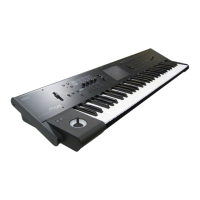COMBI P8: IFX (Insert Effect) 8–1–1: Routing1 T01–08, 8–1–2: Routing1 T09–16
113
COMBI P8: IFX (Insert Effect)
You can also specify the bus routing for the program used by
each of the timbres, 1–16. For instance, you can:
• Send the output of a timbre to an insert effect
• Route a sound to an insert effect
•Make detailed settings for insert effects
•Make common LFO settings for effects
For more details on the Insert Effects, please see the “Effect
Guide” on page 271.
COMBI P8–1: IFX
8–1–1: Routing1 T01–08,
8–1–2: Routing1 T09–16
Specifies the bus to which the program oscillator(s) used by
timbres 1–8 and 9–16 will be sent. You can also set the send
levels to the master effects from this page.
8–1–1(2)a: Routing Map
This shows the status of the insert effects.
This area shows the insert effect routing (Bus (IFX/Output)
Select), the name of the assigned effect, the on/off status,
chaining, and the output bus that follows the insert effect.
The type of insert effect, the on/off status, and the chain
settings can be edited in the 8–1–3: Insert FX Setup page.
8–1–1(2)b: Combination Name
8–1–1(2)c: Timbre Info
For more information, please see “2–1: EQ Trim T01–08, 2–2:
EQ Trim T09–16” on page 93.
8–1–1(2)d: Routing1
Bus (IFX/Output) Select [DKit, L/R, IFX1...5, Off]
This specifies the output bus for the timbre’s program
oscillator. This parameter can also be edited from the P8–2:
IFX Routing 2 T01–08, T09–16 page.
L/R: Output to the L/R bus.
IFX1…5: Output to the IFX1–5 buses.
Off: The timbre will not be output from the L/R bus, or
IFX1–5 buses. Choose the Off setting if you want the
program oscillator output of the timbre to be connected in
series to a master effect. Use Send1 (to MFX1) and Send2 (to
MFX2) to specify the send levels.
Tip: You can create a wide variety of routings by using each
timbre’s Bus (IFX/Output) Select and the Chain to and
Chain settings (Combi 8–1–3b) that follow the insert effect.
Example: Inserting a single IFX into multiple timbre
Example: Inserting a separate IFX into each timbre, and then insert-
ing an IFX at the final stage
Example: Sharing a portion of a timbre’s IFX chain with another tim-
bre
DKit: This can be selected only if the timbre’s program is a
drum program (Oscillator Mode Drums).
The Bus (IFX/Output) Select, FX Control Bus, Send1, and
Send2 (Global 5–4b) settings for each key of the selected
Dkit will be used. Check this setting if you want to apply an
individual insert effect to each drum instrument.
Tip: In most preloaded drumkits, the drum instruments have
the same Bus (IFX/Output) Select settings according to their
type, as follows.
Snares → IFX1
Kicks → IFX2
Other → IFX3
If you want to edit these routings, use the DrumKit IFX
Patch menu command. For more information, please see
“DrumKit IFX Patch” on page 123.
8–1
–1a
8–1
–1
Menu
8–1
–1d
8–1
–1b
8–1
–1c

